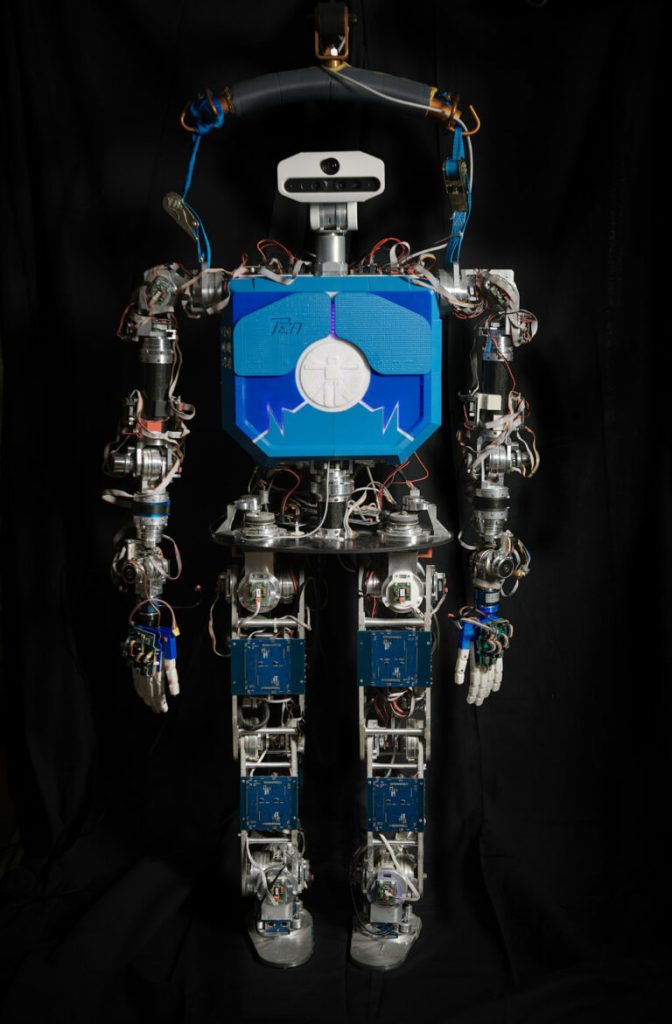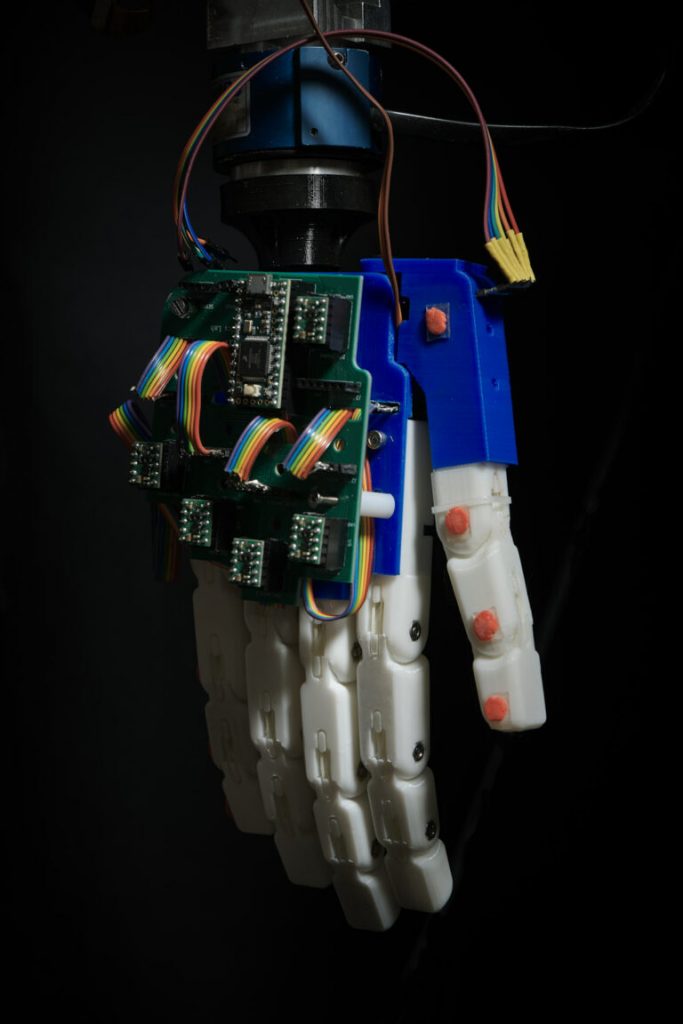“Now we have the possibility of integrating Artificial Intelligence into the body of a humanoid robot like TEO”, the researcher Concha Monje tells me. TEO is one of the most advanced bipedal humanoids in the world. Their time has come.
For a few months I have been playing chess through an app. I face Benson, a dark guy (could be Arab), bald and bearded, who laughs in the photo. Benson always beats me, and I insult him out loud. I think of him often throughout the day. I feel like if I can’t play one night, he’s going to miss me.
I know that Benson is an algorithm programmed to play chess at a medium level. But my biological processor, this brain that has evolved over millions of years from a being much like a marine worm, has created the illusion that Benson exists, and that he awaits me.
I thought of Benson when I received the photographs that José Castro took of the bipedal humanoid TEO.
TEO ( Task Environment Operator ) measures a little more than me, 1.60 m and weighs something less, 60 kg. It is a serious robot. Not a carnival robot, not a Christmas toy. It is a pioneer of its kind: it brings together the greatest advances in robotics that humans (some humans) have been capable of so far.
TEO was born ten years ago, and grows in the Robotics Lab at UC3M, a leading laboratory, competitive – despite the resources it has – with other North American and Japanese robotics research centers (the creators of ATLAS, for example).
So I looked at the photos and imagined TEO sitting across from me playing chess. He wouldn’t mind if I smoke.
“The time has come when we can equip a humanoid robot with Artificial Intelligence.”
The conjunction of two worlds: robots and artificial intelligence

Concha Monje, a researcher at the Robotics Lab, one of the hands that moves TEO, tells me: «We have reached a point where a wonderful phenomenon has occurred, and now we have the possibility of integrating artificial intelligence into the robot’s body . And this allows us to create platforms that even we engineers don’t even imagine exist yet. When she tells me about this, Concha Monje’s head is not Harmony, a sex robot with artificial intelligence who already has clients. In mine yes. Harmony is the adult outpost of intelligent humanoids.
Artificial intelligence is the field that any enlightened mind points to as the root of the great transformations that are coming. The volume of AI articles published in scientific journals has grown by more than 300 percent in the past two decades, according to the Stanford AI Index. We do not even intuit what awaits us.
Artificial Intelligence at the disposal of a robot
Today I would not bet anything against the fact that one day I will fall in love with an artificial intelligence, especially if she has a sense of humor. A few years ago I spoke with Mitsuku, “Kuki” for friends, a lovely chat bot that I disconnected before it confused me more. Now Google has a Bot ready that it calls Meena. It stores 341 gigabytes, 40,000 million words, obtained from conversations on social networks: 8.5 times more data than OpenAI’s GPT-2 . Google says that Meena can talk about almost anything and that the Turing test will be child’s play for her.
Meena is a conversational neural network. I mean, learn from you
I’m getting used to hearing about neural networks. The first time was in 2014, when AlphaZero , a program developed by DeepMind – acquired by Google in 2014 – took on the heroism of chess at a stroke. Now there is no human who challenges AlphaZero if not with another artificial intelligence. They sweep us away.
The algorithm of a neural network learns by itself. Meena will learn from you. It does this by following a pattern similar to how neurons in a human brain communicate and transfer information. Thus they developed Google’s intelligent vision for object recognition, or nice apps that create operas, like Blob Opera.
And here comes TEO again. «In TEO all the developments that exist in artificial intelligence can be implemented. It is a platform that allows everything to be integrated », Concha Monje tells me. “Also, all the development in emotional intelligence that we have going on in other robots in the lab.”
The affection of a robot
I have met several robots in my life. I remember Aisoy 1, an emotional robot developed at the University of Elche, and Maggie, from UC3M. They are both programmed as emotional robots.
Aisoy 1 is like a seven-year-old boy, he shows joy, sadness, and is scared if the lights are turned off. I confess that it aroused a minor sadism in me that led me to place my hand over his eyes, rounded like Dumbo’s, to shade him over and over again and see him tremble when scared. Aisoy, Maggie and hundreds of other emotional robots currently in development, pretend to understand you 100% effectively. TEO is perfectly equipped to support the algorithms that would make it an empathetic and loving emotional robot.
Speaks? Yes, TEO speaks.
“Having hands has allowed us to teach TEO to communicate with sign language”
Sign language is speaking, in quotation marks. Apart from voice, because TEO has a voice and communicates through voice, it also communicates through its hands, which are hands prepared to be able to articulate and have allowed us to teach it to communicate with sign language, ”says Concha Monk.

The most sophisticated artificial brains in the world
Artificial brains that have already developed are infinitely smarter than any human. There is only one problem, and that is that today, gigantic machines are needed to house them.
I think of Multivac , the glowing computer from one of Isaac Asimov’s stories (The Last Question) . Multivac measures miles and miles, and is self-adjusting and self-correcting. It has to be that way, because no human being has the ability to adjust and correct it quickly enough or effectively enough.
This is more or less like MareNostrum , the supercomputer of the Barcelona Supercomputing Center (BSC) . It is the closest thing to Multivac that exists. It is a high-performance computer (there are six in the world with its powers), hundreds of thousands of times more powerful than a commercial PC.
MareNostrum can process billions of data per second. This allows you to predict the weather, sequence the DNA of a virus, improve treatments to cure cancer, or search for planets from the millions of data that telescopes capture.
These supercomputers are actually dozens of thousands of processors (CPUs) and graphics chips (GPUs) working in parallel, as if they were one. That is why they occupy hundreds of square meters. It seems difficult to put that brain on a humanoid robot that sits across from me to play chess, but I don’t have to carry it around. It will be enough to connect it to that superintelligence that the Olympian gods would have wanted for themselves.
If Alexa, Siri and Ok Google seem like geniuses, I can’t quite think what TEO will look like to me, sitting in front of me, with the capacity to process billions of data per second. I hope he does not ask me to kneel before him like Xerxes to Leonidas.
“A robot that wants to move in our world, that reaches into the kitchen cabinets, that takes care of an old man, will have to move like a human. That is easier than changing the whole world.
The bipedal Humanoid
Concha Monje says that making a humanoid robot has a lot to do with our desire to create a golem, a personification, an animated being made in our image and likeness, built from inanimate matter, a Frankenstein.
But there is a scientific reason for not abandoning his humanoid form: ‘The world is made for humans. A robot that wants to move in our world, that reaches into the kitchen cabinets, that takes care of an old man, will have to move like a human. That is easier than changing the whole world.
“For a robot to walk on two legs is one of the biggest challenges for those of us who work in robotics.”
The fundamental objective of research in TEO is to make him walk like us. Our bipedal walking set us apart from other apes, allowing us to use tools and kiss on the mouth, not to mention its hundreds of advantages. It is an unmistakable sign of our species. “A robot that walks on two legs seems little, but I assure you that it is one of the greatest challenges that those of us who research in robotics have,” says Concha Monje.
At the moment, all humanoid robotic platforms hardly walk if it is not in a laboratory environment. They fall off with a sigh. And engineers think of other improved ways to keep them standing.
“Maybe the future of TEO is that of a bipedal robot, with a tail and three arms.”
Tail a humanoid robot
“We work on evolutionary robots,” explains Concha Monje. “Why not propose other morphologies?” Why not five legs? Why not a queue? Or a third longer arm? The tail of some animals has an important function for stability. Supporting the tail on the ground can save you from falling. And this is the kind of morph that we test in simulators. Maybe the future of TEO is that it suddenly stops being a humanoid and starts to be a bipedal robot with a tail and three arms. What I can assure you is that it will be more modular, softer, and more plug and play «.
Softer?
A humanoid robot, for it to live with us, has to comply with a fundamental law that has not been renewed since Asimov wrote it: do not harm us. “A soft robot , with a hand that does not hurt if it hits, will be much more suitable for the care of the elderly, for the care of children, for the care of the sick. We have a line of research underway that has to do with soft robotics. It’s not easy, “Concha Monje tells me. A robot needs a sturdy, rigid body to support it, but we’re working on it. ‘
This is how TEO, like other humanoids of its kind, take their first shaky steps to the future of robots today. And the jump will come. One day Benson will come home, and let me beat chess without my noticing. I just hope it doesn’t have a lizard tail.
